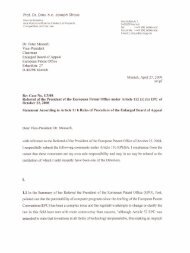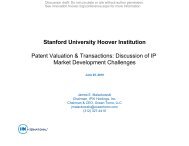Assessing the Obstacles to Industrialisation: The ... - Innovation
Assessing the Obstacles to Industrialisation: The ... - Innovation
Assessing the Obstacles to Industrialisation: The ... - Innovation
You also want an ePaper? Increase the reach of your titles
YUMPU automatically turns print PDFs into web optimized ePapers that Google loves.
24 Stephen H. Haber<strong>The</strong> two most salient characteristics of this class of merchant-financierindustrialistswere that few of <strong>the</strong>m were Mexican by birth and fewer stillknew anything about manufacturing. Of <strong>the</strong> nine men who made up <strong>the</strong>first board of direc<strong>to</strong>rs of <strong>the</strong> Fundidora Monterrey steel mill, for example,only one had any relevant technical experience.61 <strong>The</strong>se were not <strong>the</strong>tinkerers of <strong>the</strong> English Industrial Revolution or <strong>the</strong> productionorientatedengineers and scientific managers of US industry. <strong>The</strong>y werefinanciers whose principal talents lay in making deals <strong>to</strong> maintain <strong>the</strong>irmonopoly positions and in manipulating <strong>the</strong> economic apparatus of <strong>the</strong>state <strong>to</strong> provide <strong>the</strong>m with protection from foreign and domesticcompetition. <strong>The</strong>ir presence on <strong>the</strong> boards of Mexico's major manufacturingenterprises <strong>the</strong>refore reinforced <strong>the</strong> tendency of Mexicanindustry <strong>to</strong> collude ra<strong>the</strong>r than compete.<strong>The</strong>se merchant-financier-industrialists were well positioned <strong>to</strong> shapegovernment policies <strong>to</strong> <strong>the</strong>ir liking. Indeed, <strong>the</strong>y were <strong>the</strong> economicbackbone of <strong>the</strong> Porfirian state: <strong>the</strong>y subscribed <strong>to</strong> <strong>the</strong> government'streasury bonds, <strong>the</strong>y sat on <strong>the</strong> boards of <strong>the</strong> nation's most importantfinancial institutions and <strong>the</strong>y represented <strong>the</strong> government in internationalfinancial markets when it borrowed money abr~ad.~' In fact, it was not somuch a case of <strong>the</strong> state representing <strong>the</strong> interests of <strong>the</strong>se financiers as itwas that <strong>the</strong>se financiers were <strong>the</strong> state. <strong>The</strong>y controlled <strong>the</strong> emission ofpaper money through <strong>the</strong>ir ownership of <strong>the</strong> Banco Nacional de MCxico<strong>the</strong>re was no government-run central bank. <strong>The</strong>y shaped nationalmonetary and exchange-rate policy through <strong>the</strong> seats <strong>the</strong>y occupied on <strong>the</strong>Comision de Cambios y Monedas, and <strong>the</strong>y held <strong>the</strong> strings on <strong>the</strong> flowof international loans <strong>to</strong> <strong>the</strong> Mexican government through <strong>the</strong>irconnections <strong>to</strong> <strong>the</strong> major banks in Madrid, Geneva, Paris and New York.This class of merchant-financier-industrialists used <strong>the</strong>ir political andeconomic power <strong>to</strong> pursue rent-seeking strategies. At <strong>the</strong> same time,poorly developed capital markets kept o<strong>the</strong>r groups from challenging<strong>the</strong>ir hold on industry. That is, ra<strong>the</strong>r than make innovations in newprocesses or techniques as entrepreneurs in some follower countries dld(Germany stands out as a case in point), Mexico's entrepreneurs sought <strong>to</strong>limit competition and earn monopoly rents. Given <strong>the</strong> fact that <strong>the</strong>irentrepreneurial talents and experience were in commerce and moneylending- not in production - and given <strong>the</strong> fact that demand for many of<strong>the</strong>ir products was highly inelastic, this strategy made sense from <strong>the</strong> poin<strong>to</strong>f view of maximising returns <strong>to</strong> <strong>the</strong> firm. Indeed, returns <strong>to</strong>manufacturing were low (many enterprises, including some of <strong>the</strong>61 Fundidora Monterrey, ' Informe Xnual ', I got.Lfexico's most important financiers operated on an international scale and hadconnections <strong>to</strong> <strong>the</strong> big foreign banks. See Sanchez Alartinez, 'El slstema monetario'.





